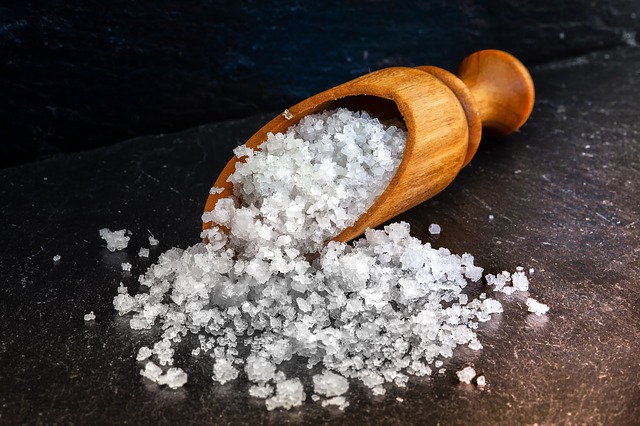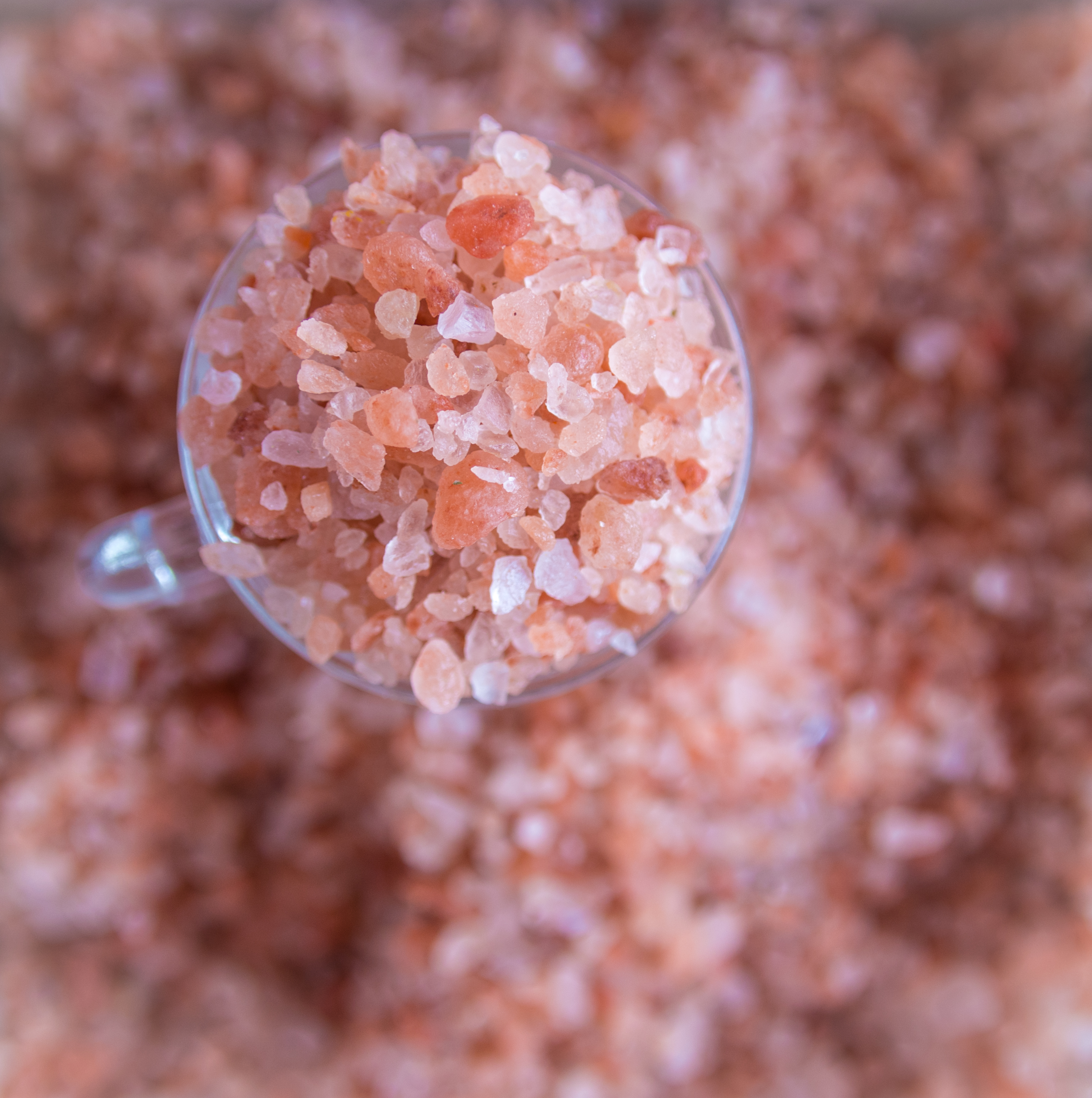Difference Between Sea Salt and Himalayan Salt

What is Sea salt?
Definition of Sea salt:
Sea salt is salt that is produced by the evaporation of seawater. Like all salts, the main component is sodium chloride. However, it can vary in terms of mineral contents aside from the sodium chloride. This is because there will be a large variation in the minerals that are found from one part of the world to another. For instance, sea salt may even contain trace amounts of lava if extracted in volcanically active regions such as Hawaii.
Extraction of Sea salt:
Sea salt is extracted using salt evaporation pans (ponds) and modern methods. These pans are ponds that are shallow and very large in area. The ponds are intentionally made large in size and shallow so as to speed up the rate of evaporation of the water from the salt.
Color and granules in Sea salt:
The color of sea salt can vary greatly from gray to pink, black or even greenish; depending on where it is formed. This is because it is influenced by other substances in the ocean including clay, and even algae. The granules tend to be larger and coarser than the granules that are found in regular table salt. The table salt is usually very refined and may even be treated with chemicals to ensure a white color. In addition, table salt may have additives, such as agents that are added to stop the granules from clumping together. The crystals of sea salt are often moist, or moister than Himalayan salt. Sea salt crystals do not dissolve quickly and thus gives a crunchy flavor to food when used.
Uses of Sea salt:
Sea salt is considered by many to be healthier than table salt if it is in the unrefined form. This is because it contains many minerals such as potassium, zinc, and iron. These are essential for maintaining good health. There is no evidence, however, that this salt is healthier than regular table salt. Some gourmet chefs believe that sea salt is better than table salt because you can use fewer granules and it gives a slightly different taste to food because of the different minerals. Studies have not shown a significant difference in taste between sea salt and normal table salt.

What is Himalayan salt?
Definition of Himalayan salt:
Himalayan salt is salt that is mined from a mountain range that is found in Pakistan in the Punjab region. The salt is from a sea, but a sea that existed millions of years ago during the Cretaceous and Permian eras. The sea became landlocked and the water evaporated leaving behind landlocked salt deposits that are now mined. Minerals that can be present aside from sodium chloride include chromium, copper, zinc, iron, and lead. Up to 10 elements have been found when Himalayan rock salt has been analyzed. Salt may also contain magnesium, potassium, calcium, and sulfates.
Extraction of Himalayan salt:
Salt does not have to be extracted from water since the water evaporated millions of years ago. This means the salt has to be excavated from the mountains where it is trapped. Traditional methods are used by miners to remove the salt. The most important mine is near Khewra in the Punjab province.
Color and granules in Himalayan Salt:
The color of the salt granules is often pink or red due to the presence of oxides but can be an off-white color. The crystals of Himalayan salt are very dry, and the granules tend to be much larger than the granules found in ordinary table salt. Himalayan salt dissolves quickly and can be used in cooking situations where the desire is to have a rapidly melting salt.
Uses of Himalayan salt:
Himalayan salt can be used to flavor food but may need to be refined first to remove dangerous impurities such as lead and copper. Slabs of salt are used to make baking stones and serving dishes. Lamps are also made of blocks of salt, by placing a light bulb inside a hollowed out block of Himalayan salt. The salt is also used as a bath salt and in various other industries.
Difference between Sea salt and Himalayan salt
-
Definition
Sea salt is salt that is produced as a result of the evaporation of seawater.
Himalayan salt is salt that is mined from the mountains in Pakistan. Himalayan salt is salt that was produced from an ancient sea that evaporated.
-
Extraction of salt
Sea salt is extracted using evaporation pans and various modern methods.
Himalayan salt is extracted using traditional methods and hand mining.
-
Color
The color of sea salt can vary from off-white to pink, greenish or black.
By comparison, the color of Himalayan salt can vary from off-white to pink or red.
-
Granules
Sea salt tends to have granules that are moist compared with Himalayan salt which has salt granules that are very dry.
-
Melting
Sea salt granules do not melt easily while, in comparison, Himalayan salt granules do melt easily.
-
Uses
Sea salt can be used in cooking and as a scrub for the skin. Himalayan salt can be used in cooking to add flavor to food. In addition, Himalayan salt is also used to make baking dishes, serving trays and salt lamps.
Table comparing Sea salt and Himalayan salt

Summary of Sea salt Vs. Himalayan salt
- Both sea salt and Himalayan salt have granules that are much larger than conventional table salt.
- Sea salt has more different colors than Himalayan salt since it is extracted from many different places around the world.
- Sea salt is extracted using evaporation pans while Himalayan salt is mined using traditional mining methods.
- Sea salt granules tend to be moister than Himalayan salt granules.
- Sea salt granules also do not melt as quickly as Himalayan salt granules do.
- Difference Between Rumination and Regurgitation - June 13, 2024
- Difference Between Pyelectasis and Hydronephrosis - June 4, 2024
- Difference Between Cellulitis and Erysipelas - June 1, 2024
Search DifferenceBetween.net :
Leave a Response
References :
[0]Image credit: https://pixabay.com/en/nature-food-salt-sea-salt-moist-3305860/
[1]Image credit: https://en.wikipedia.org/wiki/Himalayan_salt#/media/File:Himalayan_salt_of_Saúde_flea_market,_São_Paulo,_Brazil.jpg
[2]Ashley, Steven. “Drink up: taking the salt out of seawater”. Scientific American. Scientific American, 2009, https://www.scientificamerican.com/article/taking-the-salt-out-of-seawater/
[3]Broadway, PR, JM Behrends, and MW Schilling. “Effect of alternative salt use on broiler breast meat yields, tenderness, flavor, and sodium concentration”. Poultry science 90.12 (2011): 2869-2873.
[4]Papp, Zsigmond J. “Morphological and microchemical characterization of Himalayan salt samples”. Revue Roumaine de Chimie 61.3 (2016): 169-174.
